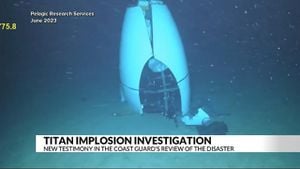Carbon sequestration, a natural process where carbon dioxide (CO2) is absorbed by plants and stored in the soil and sediments, is well-known as a crucial factor in mitigating climate change. While forests and other terrestrial ecosystems receive significant attention for their role in sequestering carbon, the marine environment's contribution is often overlooked. A recent study sheds light on the untapped potential of carbon storage within shelf sea sediments and the need for improved governance and management to harness this potential effectively.
For decades, the relentless human activity has led to a spike in atmospheric CO2 levels, contributing to global warming. However, nature itself offers several mechanisms to capture and store this excess carbon. Marine ecosystems, such as coastal wetlands, play a vital role in this process. As the study emphasizes, shelf sea sediments, in particular, have a significant yet underappreciated capacity to sequester carbon, which could play a vital part in achieving greenhouse gas emissions reduction targets.
Carbon sequestration in the ocean involves the capture of carbon by various marine organisms and its subsequent burial in marine sediments. These sediments, found in water depths of less than 200 meters, can store carbon for thousands to millions of years. However, the complexities of carbon transport and the geopolitical challenges of carbon accounting in marine environments have hindered the recognition and management of these critical carbon stores.
To put the scale of this potential into perspective, consider that the world's oceans currently sequester as much as 25% of anthropogenic CO2 emissions annually. This tremendous capacity for carbon storage is not evenly distributed but concentrated in key areas like the North Sea, where unique geomorphological conditions facilitate carbon burial in sediments. The study highlights the North Sea as a prime example to illustrate the complexities involved in managing and accounting for this carbon.
The process of carbon sequestration in shelf sea sediments is influenced by several factors. Organic carbon produced by marine organisms, such as phytoplankton, sinks to the seafloor and becomes buried in the sediment. Over time, this organic matter is compressed and can become a long-term carbon sink. However, the study notes that the transport of this organic carbon is affected by water currents, meaning that carbon produced in one territorial water may be buried in another, complicating national carbon accounting efforts.
These complexities raise important questions about the ownership of carbon stocks in marine sediments and how to integrate them into national carbon accounts. Effective management and governance frameworks are essential to address these issues. The study suggests that international cooperation and new accounting guidelines will be necessary to ensure that carbon sequestered in shelf sea sediments is accurately measured and reported.
The study's methodological approach involved a comprehensive review of existing literature on biogeochemistry, environmental economics, and marine governance. By synthesizing insights from these diverse fields, the researchers were able to provide a holistic view of the current state of carbon sequestration in shelf seas and identify key areas for improvement in governance and management practices.
One of the significant findings of the study is the identification of shelf sea sediments as potentially manageable carbon stores. This means that with proper oversight and management, these sediments could be used to mitigate climate change effectively. However, the study also highlights several challenges that need to be addressed to realize this potential. These include the need for better data on carbon stocks and fluxes in marine environments, as well as the development of standardized methods for measuring and reporting these stocks.
In terms of policy implications, the study argues that including shelf sea sediments in national carbon accounts could provide a more accurate and comprehensive picture of a country's carbon budget. This could, in turn, inform better policy decisions and enhance international efforts to combat climate change. The researchers stress that the integration of marine carbon stores into national and international carbon accounting frameworks is crucial for meeting the goals of the 2015 Paris Agreement, which aims to limit global warming to well below 2°C above pre-industrial levels.
The broader implications of this research are significant. Proper management of shelf sea sediments could play a vital role in achieving global climate targets. For policymakers, this means considering the marine environment in their carbon management strategies and implementing regulations that protect and enhance these natural carbon sinks. For industry professionals, particularly those involved in marine activities such as fishing and offshore drilling, this research underscores the importance of minimizing disturbances to marine sediments to maintain their carbon sequestration capacity.
Interestingly, the study draws parallels between the management of marine carbon stores and other common-pool resources, such as fisheries. Both require coordinated efforts across national boundaries and the development of supranational governance mechanisms to ensure sustainable management. The researchers point out that existing frameworks like the United Nations Environment Programme's Regional Seas Programme could serve as models for managing transboundary carbon stocks in marine environments.
Despite the promising potential of marine carbon sequestration, the study acknowledges several limitations. One major challenge is the lack of robust biophysical data on carbon stocks and fluxes in shelf seas. This data gap makes it difficult to accurately quantify the carbon sequestration potential of these environments. Additionally, the variability in carbon transport and storage rates across different regions adds another layer of complexity to the management and reporting of marine carbon stocks.
Another limitation highlighted in the study is the uncertainty surrounding the origin of carbon fractions in marine sediments. This uncertainty poses a risk of double-counting the benefits of carbon sequestration if the same carbon is accounted for in multiple jurisdictions. To address this issue, the researchers call for improved monitoring and data collection efforts, as well as the development of clear guidelines for carbon accounting in marine environments.
Looking ahead, the study suggests several avenues for future research. One key area is the development of advanced technologies and methods for monitoring carbon stocks and fluxes in marine environments. Satellite-based remote sensing, for example, could provide more accurate and comprehensive data on carbon distribution and dynamics in shelf seas. Additionally, interdisciplinary research that integrates biogeochemistry, oceanography, and environmental economics can help to develop more effective management strategies for marine carbon stores.
The study also emphasizes the need for international collaboration in managing marine carbon stocks. Given the transboundary nature of carbon flows in marine environments, it is essential for countries to work together to develop standardized methods for measuring and reporting marine carbon sequestration. This will require the establishment of new international agreements and the strengthening of existing frameworks, such as the UN Framework Convention on Climate Change (UNFCCC) and the Paris Agreement.
In conclusion, this study offers a comprehensive overview of the potential role of shelf sea sediments in carbon sequestration and highlights the need for improved governance and management practices to harness this potential effectively. As the researchers note, "Proper management of the carbon currently sequestered into these invisible stores, in fact, may play a significant role in mitigating climate change." By addressing the challenges and limitations identified in the study, policymakers, industry professionals, and researchers can work together to ensure that marine carbon stores contribute to global climate targets and help mitigate the impacts of climate change.



